Intel Core 2 Extreme QX6850 and Massive Price Cuts
by Anand Lal Shimpi on July 16, 2007 3:04 AM EST- Posted in
- CPUs
Gaming Performance
Our first 3D game test is our walkthrough of Bruma in the popular RPG Oblivion. This test was run at 1600 x 1200 with Very High quality defaults selected from Oblivion's launcher. FRAPS was used in this benchmark:
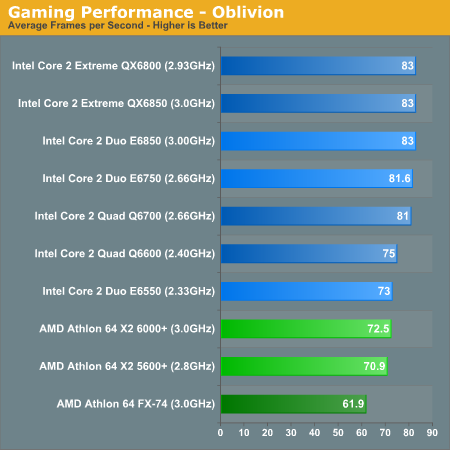
We ran Half Life 2: Episode One at 1600 x 1200, with all settings at their maximum values with the exception of AA/anisotropic filtering, which we left disabled.
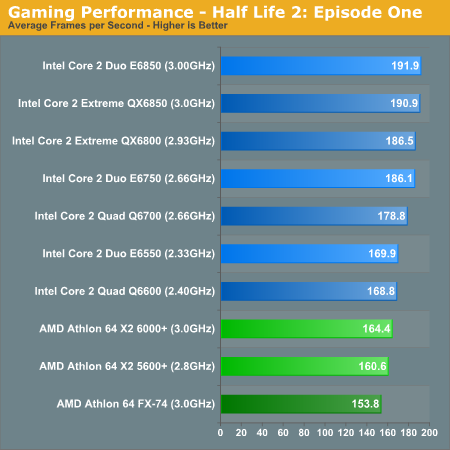
We ran Prey at 1600 x 1200 with High Quality textures, all detail settings were set to their highest options, no AA, and 8X aniso:

S.T.A.L.K.E.R. was tested at 1024 x 768 with full dynamic lighting enabled and high quality detail settings:
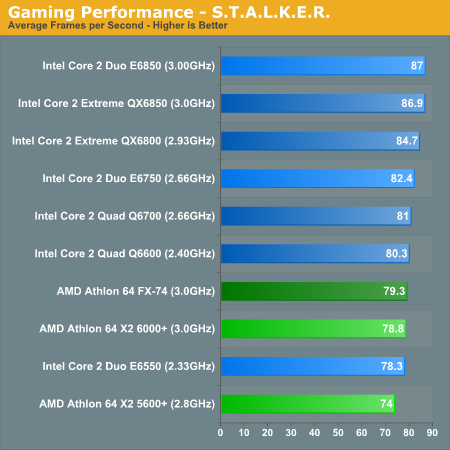
We ran Supreme Commander at 1024 x 768 with medium quality presets. We've changed our Supreme Commander benchmark a bit at the advice of Gas Powered Games' senior engineers. We created a skirmish with 7 AI players and let them duke it out for almost 30 minutes, we saved the replay and then measured the amount of time it took to playback the recording at maximum gamespeed (+10). The figures below are expressed in minutes, lower playback time being better:
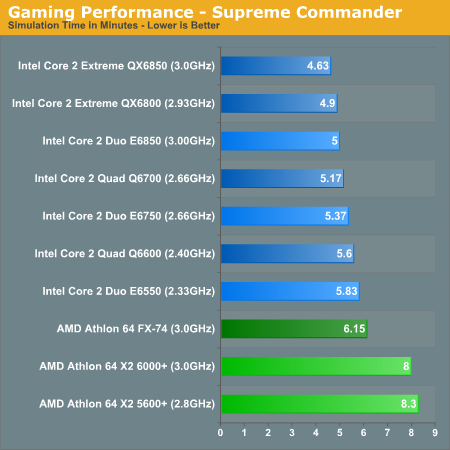
Capcom's Lost Planet demo is available in both DX9 and DX10 flavors, but for this review we used the DX9 version given that we've not been able to find any real benefit to running the DX10 version. We had to run Lost Planet at 800 x 600 with a mixture of high/medium quality settings:

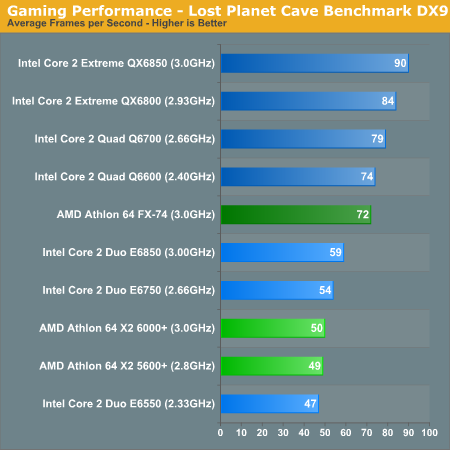










68 Comments
View All Comments
Pirks - Wednesday, July 18, 2007 - link
again, you're probably right if the silent PC is build with dual core CPU. in my case I've got single core CPU since I don't need any dual core functionality (I mostly play games like Doom 3 and S.T.A.L.K.E.R.), and while dual cores from intel are very solid choice for silent PC - single cores from Intel pretty much suck. hence my choice of AMD San Diego single core chip - that chip turned out to be the best "price/performance/watt for gaming" ratio I could find on ebay :) again, this is all about single core CPUs. I have no idea how the picture looks for dualcores, probably Intel got stronger offer here - by the time I'm about to upgrade to dual core Phenom would be around and we'll see again who wins - AMD very often wins by better price, even when their CPUs are slightly inferior to Intel onesutube545 - Thursday, July 19, 2007 - link
Oh, STFU already, you dumb fanboyPirks - Thursday, July 19, 2007 - link
what, you forgot to put some lube on your blue intel dildo again?Zak - Monday, July 16, 2007 - link
Looks like the Core 2 Duo E6850 (3.00GHz) is a decent pick for gaming machine until games take full advantage of quad-core CPU.Z.
jay401 - Monday, July 16, 2007 - link
Or if you're a budget-conscious gamer, pick up an E4400 for less than half the price and run it at 3.0GHz/1333fsb (drop the multiplier to 9x) which seems to be a pretty common and easy oc with any motherboard capable of 1333fsb.Should show little or no performance difference considering the only hardware difference is it has half the cache which doesn't seem to impact games much if at all.
sprockkets - Monday, July 16, 2007 - link
Yep, you want a nice fast platform, get Intel. But I've tested power usage of my Abit nview + 3800+ dual core 65nm processor from AMD, and it takes around 115 watts of energy at full load.I think nowadays either you get an ATX gaming system or now try to build the smallest and quietest and coolest mini itx system since they are powerful enough now for most.
bobbyto34 - Monday, July 16, 2007 - link
Yeah for normal home usage, it is interessant to find the best power consumption/ price / performance Ratio.AMD X23800+ @ 65€ was an excellent bargain (good performances ingame, though not as good as C2D).
In some cases, you want only raw performance: usually for work, less time spent waiting, gives you more productivity. At work we have to treat 1gigabyte text files, so the E6700 rocks vs other stations we have (A64 3000+ or P4 3.2Ghz) !
kataras - Monday, July 16, 2007 - link
Hello, just wanted to know is this the Core 2 Duo CPU which has no IHS (internal heatsink) on. Was it hard to remove it, do you need special tools? Did it decrease the temp significantly? I am asking this because i am thinking of either removing IHS or lapping my E6320 as it runs really hot indeed. i would be very pleased if you could answer my questions regarding IHS.Thanks
Ron
AMDfreak - Monday, July 16, 2007 - link
You can find lots of info about removing the IHS over a the xtremesystems.org forums.microAmp - Monday, July 16, 2007 - link
"... whole 7MHz faster than its predecessor may..." on page 2. Should be 70Mhz faster.